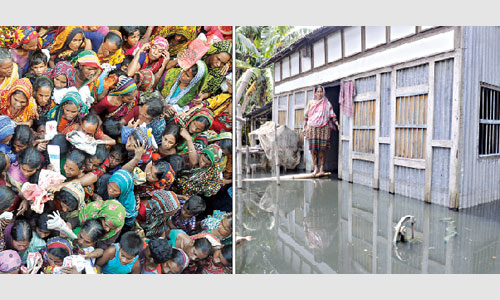River erosions making people homeless as floodwater recedes
River erosion caused by receding floodwater has started making people homeless and landless.
The floodwater was receding gradually in the affected areas due to fall of water level in the major rivers while waterborne diseases continued to spread in the flood affected districts.
In Manikganj, local people alleged that substandard water purification tablets were distributed among the flood affected people.
National Health Crisis Management Centre said that death toll from the flood rose to 74 till Friday while number of patients stood at 5,379 since July 25.
Of the deceased, five died of snake bite and 69 people, mostly minor children, were drowned into water, said officials at the centre.
The said that 751 medical teams were working in 15 flood affected districts.
The Flood Forecasting Warning Centre said that as the Brahmaputra-Jamuna, Padma and Surma-Kushiyara rivers were in falling state and the flood situation continued to improve in low lands adjacent to Brahmaputra and Jamuna Rivers in Jamalpur, Serajganj, Bogra, Rajbari, Manikganj, Munshiganj and Shariatpur.
New Age correspondent in Kurigram reported that the floodwater was receding gradually and the overall flood situation in the district was improving. The flood victims were returning to houses and repairing their damaged houses. Some houses in char areas were still inundated.
Receding floodwater caused river erosion in the district and people in various riverside areas were becoming homeless and landless, local people said.
Kurigram district water development board executive engineer Mahfuzur Rahman admitted that erosion of rivers was going on with the recede of floodwater at places.
District Relief and Rehabilitation office sources said that 6,495 families in the district already became victim of river erosion.

A human hauler driver faces difficulties as floodwater inundates the road at Louhajang upazila of Munshiganj. — New Age photo
The Brahmaputra river was devouring houses, trees and bamboo cluster at Hatea union under Ulipur upazila, Jatrapur union under sadar upazila, Raumari and Rajibpur upazila and the Teesta at Rajarhat upazila, local people said.
More than 100 people already became homeless and landless in the erosion of Dudkumer river valleys at Uttar Dhaldanga, Telai, Char Nalea, Islampur, Bhoroterchara, and Gonairkuti village under Bhurungamari upazila, local people said.
New Age correspondent in Manikganj reported that the flood-affected people in Manikganj were cheated by health workers being given water purification tablets ‘Halazone’ that became useless. The people were being sick after drinking water purified by the tablets.
The tablets are manufactured by Hind Pharma in Bhopal in India in September in 2014 and were supposed to be expired in August 2016.
Manikganj Civil surgeon Emran Ali said that the tablets became useless due to lack of proper preservation. ‘I asked my team members to recover the distributed tablets and not to distribute the tablets further,’ he said.
Manikganj deputy commissioner Rashida Ferdouse said that she was informed about it. She also directed upazila nirbahi officers to recover the distributed halazone tablets from the flood-affected people through the chairmen of the union parishads.
About three lakh people of 43 unions of Harirampur, Daulatpur, Shivalaya, Ghior, Saturia and Manikganj upazila of the district were under threat of health hazards as the floodwater began receding.
The ferry movement on Paturia-Daulatdia river route was likely to be disrupted anytime as two landing stations at Daulatdia terminal were washed away and two others were also under threat of erosion of the river Padma, said Bangladesh Inland Water Transport Corporation manager (commercial) at Daulatdia office Shafikul Islam.
In Munshiganj, flood situation improved but sufferings of the affected people increased. Several people in 50 villages in three upazials were marooned by the flood. The strong current was eroding bank of rivers and at least 15 houses at Khariar Char under Lauhajang upazila were washed away.
In Shariatpur, although flood situation slightly improved, several lakh people were stilled marooned by flood. The flood victims were leading miserable life.
The people were being victims of river erosions in the district. Deputy commissioner Mahmudul Hossain Khan said that dry foods, cash and rice were being distributed among the affected people.
In Sirajganj, the flood-affected people were deprived of various necessary medicines as family planning department officials were allegedly not distributing the medicines.
There was no supply of 28 essential medicines for 4-5 months, said deputy director of family planning in Sirakganj. The matter was conveyed to the higher authorities, he said.
New Age correspondent in Khulna reported that water-level in Khulna rivers was flowing above the danger level and floodwater started to enter Khulna city. Several thousand of people at Dighalia upazila were marooned. In the flooded areas, there was crisis of drinking water. Many fish farms were washed away.
News Courtesy: www.newagebd.net











